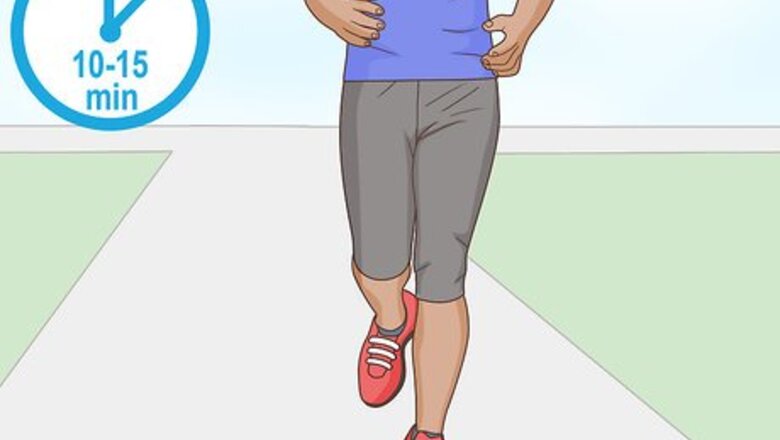
views
Acclimating Your Body
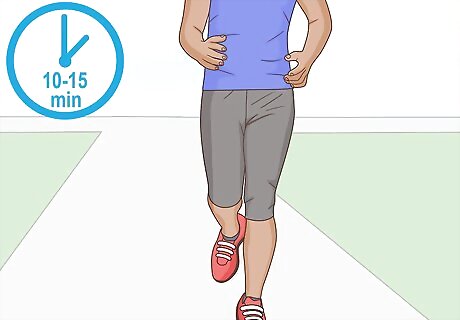
Warm up for 10-15 minutes to minimize the shock effect. It’s important to get your muscles warm and your heart pumping before you get into cold water. Take a brisk jog or walk or do several sets of jumping jacks. You can also jump rope.
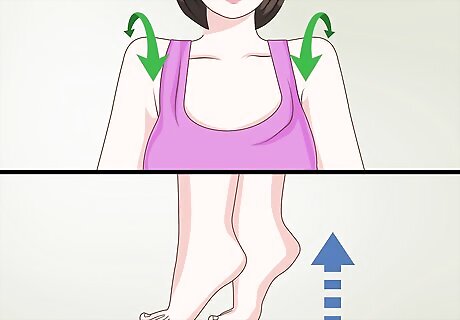
Stretch out if you’re feeling stiff. If your body is tight before you begin your cardiovascular warm up, consider stretching out your body. Roll your shoulders forward and backward a few times and lift yourself up onto the balls of your feet. You can also lift your feet up behind you (one at a time) until they touch your buttocks and hold them there for thirty seconds to stretch your quadriceps.
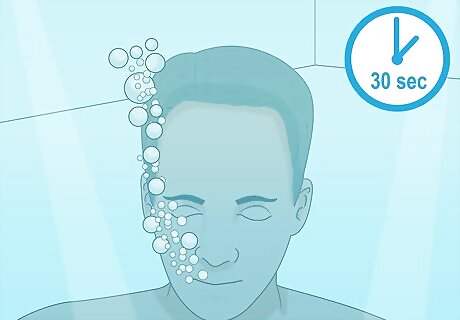
Go in waist-deep and blow bubbles. Getting your face used to the water temperature will help regulate your heart rate. Once you’re in the water up to your hips, dip your face in and blow air out through your mouth. Lift up your face when you need to breathe again, or after about thirty seconds. Repeat this a few times.
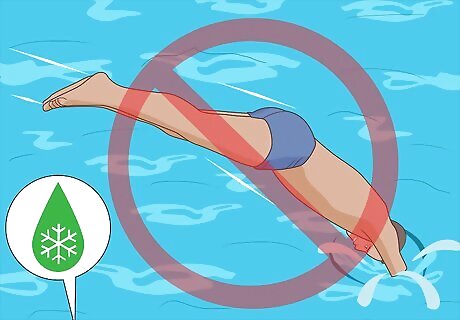
Avoid diving into cold water. Diving straight into cold water could put your body into shock. This can cause hypothermia and could be fatal. Diving in is especially dangerous if you’re not used to swimming in cold water, but it’s better for experienced cold-water swimmers to get in gradually as well.
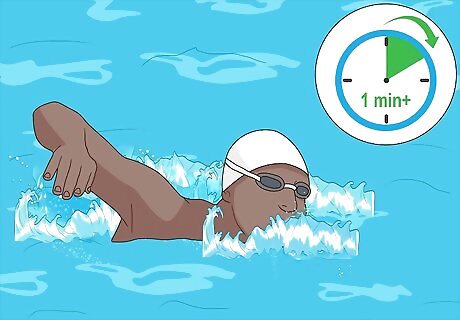
Increase the amount of time you spend in cold water slowly. The acclimation process (or getting your body used to swimming in cold water) takes some time. At first, you may only be able to swim in water under 70℉ (21℃) for a minute or so. Use training sessions to increase the amount of time you can stay in comfortably and safely in small increments. How quickly you increase your time and how much total time you eventually spend in the water will depend on how cold the water is. For lower temperatures (anything near 50℉ or 10℃), you may only be able to do a minute or two at a time.
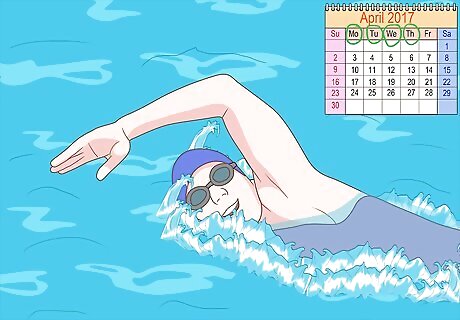
Train three to four times per week to keep acclimating. Keep your training consistent. Do twenty- to thirty-minute sessions at least three times per week. If you’re still acclimating, you can use these sessions to gradually get in the water for short periods of time. Once you’re acclimated to a particular temperature, you can try swimming for twenty to thirty minutes straight. Remember that some temperatures will be too cold for any extended swimming. Keep tabs on your body, and get out if you’re struggling to breathe or notice that your body is turning white or blue. Any time you begin gasping for air, hop out of the water.
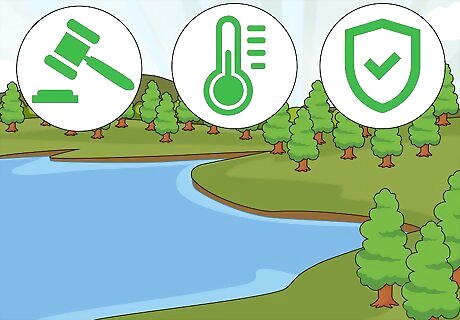
Swim in cold-water sources outdoors if you can. Open-water sources like calm rivers, lakes, and gentle oceans provide great training ground for cold-water swimming. Always be sure to check the temperature and safety conditions before swimming. Also ensure that you’re legally allowed to swim in the source. You can contact local governmental officials to find out if there are regulations or restrictions on swimming. You may also be able to adjust the temperature in indoor pools for training.

Use an ice bath as a backup option. If you’re not close to any cold-water sources, make an ice bath! Get a bag of ice at a gas station and add it to your water. Use a water-safe thermometer to check the temperature. Gradually increase the amount of time you can spend in this water, which you shouldn’t make below 50℉ or 10℃. You can train in an ice bath for about fifteen to twenty minutes, three to four times per week.

Warm up with clothing and a hot drink. Avoid taking a hot shower or getting into a sauna right after a cold-water swim. This can actually lower your body temperature further. Instead, warm up with dry clothes and towels. You can also slowly sip on a hot drink.
Wearing Essential Gear

Wear at least one cap to retain heat. Water under 70℉ (21℃) is considered cold and can cause you to have a harder time breathing. You should always wear at least one and possibly two to three swim caps when swimming in cold water. This will prevent heat from escaping through your head.
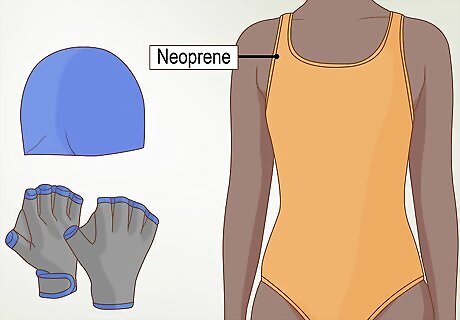
Choose neoprene materials over other options. Neoprene adds insulation and helps keep you slighter warmer than silicone, latex, or rubber caps, gloves, or socks. While it won’t reduce drag to allow you to swim faster, it’s still the best choice for cold-water swimming.

Put in earplugs for additional heat retention. Like a swim cap, earplugs slightly reduce the amount of heat escaping from your body. Look online or at your local sports supply store for earplugs designed for swimming.
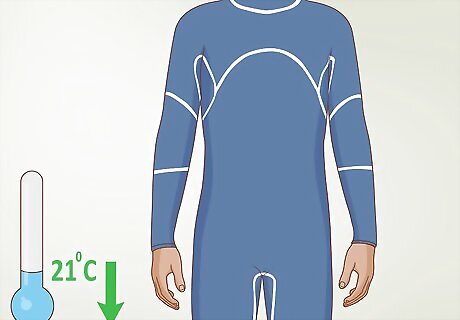
Wear a full wetsuit in temperatures under 70℉ (21℃) for safety. It’s safest to wear a full-body wetsuit when swimming in cold water. While a wetsuit won’t keep you from feeling the cold water, it will add essential insulation that’ll help you stay warmer for longer. There are competitive “ice swimmers” who swim in extremely cold water (as low as about 40℉ or 4℃) without wetsuits. This is a professional sport with high risks, demanding intense, multi-year training. Do not skip a wetsuit unless you’re a pro!
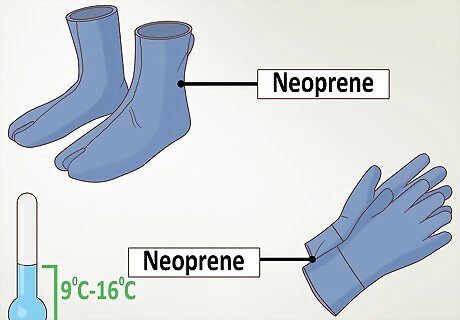
Use gloves and socks for added protection in colder water. For water between 48℉ about 60℉ (9℃ to 16℃) or lower, go for extra accessories. You can purchase neoprene socks, booties, and gloves that will help keep your extremities from going numb. They may slightly reduce your movement, so take some time to get used to wearing them in training.
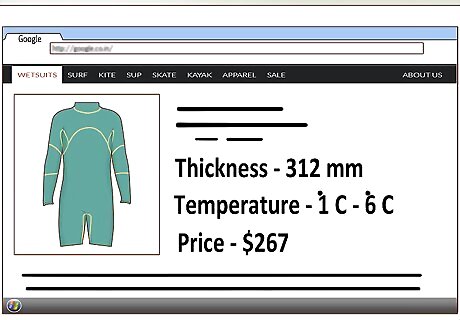
Choose thicker wetsuits for extreme cold. As the temperature falls, your wetsuit should get thicker. While thicker wetsuits make you more tired faster, they’re still worth it. Go online or to your local sports supply store to find suits specially made for your exact temperature range.













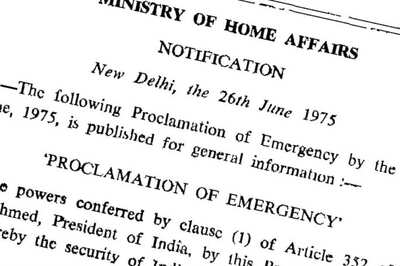






Comments
0 comment